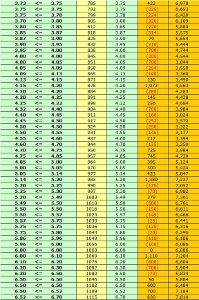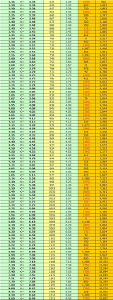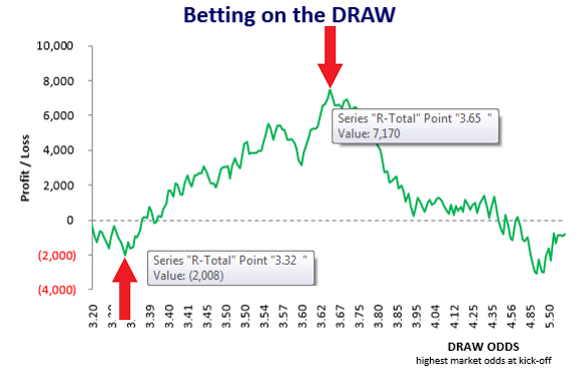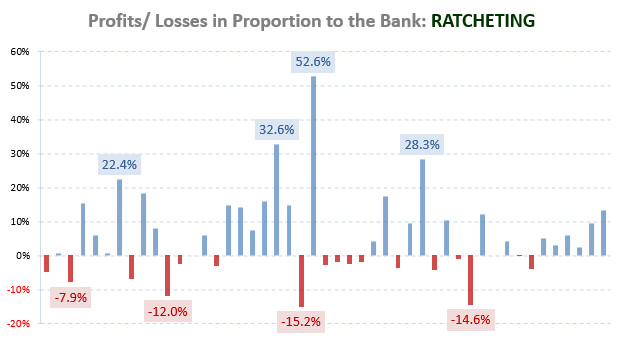
We decided not to remove this post from the site because of the many questions and answers in the comments section. For those of you with curious minds it may also be quite interesting to see how our HDAFU Tables have developed over the years.
Read about: The Power of the 7th Generation of The HDAFU Tables
Our HDAFU tables have evolved tremendously over the years. They are a complete statistical analysis of historical performance over the previous five seasons of the Home win, Draw, Away win, Favourite win and Underdog win (H-D-A-F-U). They serve to identify the most profitable odds ranges in each bet type.
To help you understand why we value this product so highly, here is our Definitive Guide for using the 5th Generation tables to their maximum potential.
It’s difficult for us to put into words how important the HDAFU tables are to us and our own betting adventures. But what we can say is that we have complete confidence in them to do their job. And from testing them in a live setting, we know that they are an extremely reliable method of building lucrative betting portfolios.
Quite simply, they are the best and most user-friendly tools available for nailing down value betting systems in every league you apply them to.
They reveal the DNA of a league, and provide a hidden level of detail that makes finding and exploiting the sweet spots so easy and so rewarding.
The next six steps will probably change the way you think about betting…
Step 1 – Observation
By default, the HDAFU tables open on the Data Tab showing the financial summary of each bet type. Here are the figures from an example league.
(Click on the image below to enlarge it in a new tab):

The totals along the top row show the effects of betting on every match over five seasons. In our example league the totals are (from left to right) Home win (-7,329), Draw (-835), Away win (+8,236), Favourites (-2,594), and Underdogs (+3,501).
You can see from this graphic that away wins look the most promising backing system with a profit of 8,236 units from 100 unit stakes.
To customise the stake amount enter what you want in the Fixed Stake box at the top of each bet type in the Data Tab.
The image above shows the full five season cold analysis. If you enter a different stake amount the financial values will change, but the percentages will always remain the same. This being the case, we have fixed these percentages as a benchmark to better gauge the improvements we will make with our filtering exercise later.
The Odds Toggle is for testing the effects of the odds you are getting when playing the systems for real – you can ignore it during your analysis.
You can also leave the betting exchange commission rate at zero. Again, use it for backing system monitoring purposes when you start betting on or paper testing your systems of choice.
Okay, we fancy away wins in this particular league but let’s now have a look at the Inflection Points Tab to see if this backs-up our observation.
(Click on the image below to enlarge it in a new tab):

Away wins are certainly financially the most profitable bet type but the profit curve doesn’t really begin rising until odds of 3.30 are reached. Overall profit at this point is 463 units and this rises to a peak of 13,502 units around odds of 8.60.
These two points on the graph would therefore be our two inflection points: Odds of 3.30 where the curve begins to rise; Odds of 8.60 at the pinnacle, the point at which profits begin to fall again.
However, notice there is a big portion of the away wins curve which is a zero-sum game. This ‘hole’ in our profit curve begins around odds of 3.75 (6,653 units). At this point, the curve falls away again, encounters what we call ‘statistical noise’, and only recovers at odds of around 6.52, when the profit figure surmounts its previous high at 7,184.

In between these two points is the potential for a lot of wasted effort and not a lot of gain.
We can see the extent of this by scrolling down and looking at the inflection point intervals.
(Click on the right-hand image to enlarge it in a new tab):
This image shows the start of the 3.75 odds sector at the top and the end of the 6.52 odds sector at the bottom.
The yellow column indicates the running total of matches up to each cluster of matches.
We can see that our two odds of 3.75 and 6.52 encompass roughly 330 matches – the difference between 1,115 indicated at the 6.52 break-off point and 785 at the starting point of the 3.75 cluster.
That’s 330 bets over a five season period that are simply not worth making; or 66 bets in a season.

We can see this clearer by looking at the same snapshot between our original inflection points of 3.30 and 8.60.
:(Click on the left-hand image to enlarge it in a new tab)
In this odds range, we have roughly 587 bets (1,221 minus 634). We now know that more than 56% of these (330 bets) are not worthwhile making.
This leaves only 257 bets but the away win profit sectors between the inflection points seem to be split into two areas of the curve: from odds of 3.30 to 3.75 (medium risk system, accounting for around 160 bets), and then from odds of 6.52 to 8.60 (high risk system; around 100 bets).
If we were to continue our analysis of away wins we would eventually see that the three elements (the medium risk sweet spot, the high risk sweet spot, and the statistical noise in-between) combine to give us a bumpy ride.
Our expected hit-rate will be tempered by that area of noise, and yield will be lower because of the size of the zero-sum area and the number of pointless bets within it.
This means a lot of unpaid work to perform, placing many bets that maintain the status quo and not much else. On top of this, the losing streaks will be greater.
Therefore, why not split into two systems in this league?
The synergy we have mentioned before about many systems supporting each other is what makes the HDAFU betting systems so viable.
However, we also mentioned that you should find the single best system in a league to play alongside the other best systems in the other leagues within your portfolio.
In our away win example, we would need to choose the better of the two systems we have identified. Either backing away wins at odds between 3.30 and 3.75, or between 6.52 and 8.60. Choose one or the other, not both.
We recommend never to play multiple systems in the same bet type. The synergy effect is diminished as ultimately, one of the two systems is not the best we can find.
Ideally, we are looking for synergy between the absolute single best systems in each league within our portfolio, without creating a situation where one system supports another within an individual league.
With different bet types in the same league (e.g. 1×2 market and over/under goals market) this is not an issue, but we would go as far as avoiding the conflict of interest between HT and FT 1×2 systems in the same league, for example.
Away wins initially looked great but is there something better?
Have a look once again at the Inflection Points graphs to try and see what it is.
As is typical of an underdog backing profile, the high risk/high return nature of this bet type produces a noisy curve, one full of jagged peaks and troughs. There are only small rising areas to analyse. Anything you can analyse into promising profits will contain few betting opportunities in a season, with long runs of losing bets to cope with.
Backing the favourite has one area between odds of 1.90 and 2.10 but we can see at these odds not a huge profit is created over five seasons (less than 3,500 units).
The home win is a misery for backing. Again, the sweet spot is between 1.90 and 2.10 but the profit is less than 2,000 units.
That leaves us with backing the draw. There is a large, rising area in the curve beginning at draw odds of 3.32 (-2,008 units), and peaking at 3.65 (7,170 units). It represents a potential profit chunk of 9,178 units over five seasons.
This is better illustrated by superimposing our inflection points onto our graph – We are interested in only the portion of the curve in-between the red arrows:

The shape of this curve is what you should be looking for when identifying the first system to analyse in your leagues of choice.
It is the classic, gently rising curve from bottom left to top right. It is relatively smooth, with a far smaller amount of statistical noise.
Therefore, this is the bet type we will analyse as our example.






Hi Right Winger,
did you notice the inclusion of Asian Odds website in the list of compulsory bookmakers on Oddsportal? What do you think about that? Is kinda strange because Asian Odds is not a bookmaker but more like a odds comparison website like Oddsportal.
Hi Daniel,
Yes, I saw Asian Odds appear on Oddsportal’s compulsory list of bookmakers around a week ago.
They are a multi-bookmaker platform like Vodds, Premium Tradings or Sport Market and, like the others, provide access to Pinnacle for customers living in territories where Pinnacle does not have a trading licence.
I am not sure of the legalities involved, but I would imagine that as access to Pinnacle is via a surrogate, so long as the surrogate has a licence to trade in your geographical zone, then all should be good and well.
They also include access to five other sharp Asian books, with bets being accepted on an aggregate basis. In other words, you place one bet, but the odds you buy are split into perhaps several lines, with the possibility of all six bookmakers accepting a portion of the risk.
In other words, your stake is divided between the bookmakers willing to match the odds you require but, to all intents and purposes, your bet is settled as just one transaction via the Asian Odds platform. Asian Odds probably operates on a commission basis, taking miniscule percentages of turnover sent to the bookmakers on its panel. (But no commission is charged to the punter).
This type of arrangment is how insurance portfolios are mainly arranged for complex risks in the Lloyd’s of London market, with multiple insurance companies underwriting proportions of the risk until it is 100% filled (covered). In this way, we see once again that insurance and gambling are intrinsically linked.
For the sake of the HDAFU Tables, ignore Asian Odds for the time being as the time stamps of their odds seem to be unreliable at present. Besides, their odds should be no better than Pinnacle’s own.
Let me know if you have any further observations on Asian Odds. The prevalence of multi-bookmaker platforms is something that I believe will become more common.
Essentially operating as a cooperative, they undoubtedly offer greater liquidity and, as they are low margin, high turnover businesses, your account with any multi-bookmaker platform should never be limited, compromised or banned: That’s good news for us all!
It’s me again. I have found myself in a very interesting situation. A system of mine has a range of 2.95 to 3.15. In oddsportal, nearly all the bookies show odds between 3.05 and 3.10, which is well inside my range. HOWEVER, only my bookie Pinnacle has odds of 3.25! What should I do now? The market as a whole shows that the best must be made, but only because of one or two bookmakers, the bet doesnt fit in the system, because the highest odds are outside the range. And its not Marathon or Tempo, its my bookie of choosing. Should I bet?
Hi Rado,
In general, you will need to make a decision if you are using just one bookmaker to place bets if and when you encounter the situation you have described above.
Either place all bets where the criteria you have described is apparent, or decline all bets. Don’t place some and not others.
Pinnacle’s historical odds are utilised in the data set for each HDAFU Table. Therefore, if Pinnacle’s odds are outside of your inflection points odds range, then technically the bet should not be placed.
However, if the rest of the market says the bet is inside your inflection points and just Pinnacle are offering odds slightly above the market benchmark, then the extra value you will gain from taking the higher odds will probably mean you will make a profit from these bets in the long run. The lower implied probability of entertaining higher odds should not make too much of a difference as some of these bets will win and some of them will lose.
I suggest if you are going to place these bets then set yourself a margin of error either side of the two inflection points – say no more than 5% difference between the benefit on offer of the higher odds (or -5% difference on the lower inflection point odds). The example you mentioned comparing the odds of your upper inflection point of 3.15 with Pinnacle’s 3.25 produces an increment of 4.65%. (225 divided by 215). Stick with whatever you decide to do and follow it through consistently.
Rado, I hope this is self-explanatory and helps in some small way.
And one more:
5. How accurate/recent are the odds in oddsportal. I mean, how often are they refreshed? If I decide to try and place bets on the last hour before kickoff and enter oddsportal, will the odds be accurate enough to just read them and place the bet immediately?
Hello again Rado,
I will answer your points seriatim:
1. It should be possible to place bets the evening before kick-off so long as you understand how the market moves. As per my reply to you of 2 September 2017 at 12:49 pm (comments section of the Winter League Tables Sales’ Page), home wins and favourites are easier to place longer term.
However, as the HDAFU Tables are all configured based on highest odds at/near the close of the ante post market, you will experience more consistent results the nearer to kick-off you can place your bets.
2. Missing the beginning of a season should not affect you in any way. I have written about the ‘conveyor belt’ analogy in my comment dated 21 August 2017 at 3:58 pm (comments section of the Winter League Campaign article).
3. If you are firm about full-season analyses only, then yes, you will have 12 systems. Please refer to pages 1 and 4 of the Winter League Campaign article for full information on how you can assess the risk composition of your chosen portfolio of systems and why a healthy balance of risk is essential.
4. 5% of your starting bank is a fair stake size – I have no problem with this suggestion. And do not forget to use the stop loss and ratchet mechanisms for intelligent use of your bank, both from the perspective of protecting it (stop loss) and speculating to accumulate (ratchet).
5. Oddsportal is unfortunately a can of worms and relies on API scrapers with each individual bookmaker. These scrapers should be updating on a minute-by-minute basis, but reliability is a huge issue.
Some bookmakers’ odds are never updated from their opening offerings, whilst some stall further down the line. In order to tell if the highest bookmaker odds are still relevant at the time you are looking to place the bet, you will need to hover your mouse cursor over the odds figures of the best bookmakers to reveal the time stamps and list of recent updates.
Any results showing within the previous 30 minutes should be okay to facilitate your betting decision, but the nearer to the real time the better, is the best advice I can offer. As mentioned before, we tend to remove Tempobet, Marathonbet and 1Xbet from the equation and base decisions on the remainder.
Rado, I hope this helps and thanks again for your contribution!
Hi again, I’ve finally decided to purchase 12 tables and I have some final questions before I start betting this Friday. I am very proficient with maths and Excel and have completely understood your formulae and betting mechanics, so they are not an issue. However, I am not so proficient with the market mechanics themselves, so there are my final qustions:
1. I am pretty busy and dont have the time to follow all the matches, especially on weekdays, so if I always bet all matches on the evening before kickoff, will that impact my results so much and will it be okay with the HDAFU tables statistics.
2. I have missed 3-4 rounds from the seasons already, hope this will also not be so bad?
3. So 12 bought tables mean 12 systems, right? I have chosen to stick only with full-season systems and have found 5 favorite/home systems, 3 draws and 3 underdogs. Do you think this is a well balanced portfolio and will it have issues with covering the losses? My three underdog systems are with max odds of around 7.00, as I prefer not to venture into the highest odds teritory.
4. As said, I will bet in Pinnacle only, with a starting bank 20 times larger than my flatbet. What’s your opinion on this?
Pretty thanks in advance!
Is there anywhere where it describes what the R-total is ? that’s really throwing me off.
Thanks
Hi Amy,
R-Total is just an abbreviation for running-total.
In other words, whatever the total profit/loss is up to and including the result of the previous/last bet.
I hope this helps.
ignore my last comment, I have missed a step…..
apologies
not sure about the LWS and LLS stats. When the tables are amended to show system stats, the LWS and LLS show the streaks in relation to the odds sequence. Would it be better to show the streaks in a chronological sequence?
RW, thanks for the answer!
Just curious: why not inclued South Korea and China in the summer leagues for sale?
🙂
Gabriel,
You’re the second to ask that question on the blog – same answer I’m afraid – pure demand and supply as no-one has been interested in those leagues in the past.
We may however bend to include them in the Summer League portfolio next time around…
…Watch this space!
Hi Gabriel,
Yes and no is the answer.
The more bets you place further in advance, the more chance there is of those closer to the outliers eventually falling outside the inflection points.
This is no problem with dropping favourite prices, as we can lay the bets off with an exchange and make arbitrage. With the underdogs, we either have to let them run or lay them off at a loss.
Laying off rising underdog prices does mean that the losses can be greater than the profits we can make with laying off the favourites (larger price fluctuations possible).
The other problem of early betting is that you have to tie-up more of your money for longer periods in advance of the final hour before kick-off.
For some of us, this is okay because the bank is large enough to withstand this, but if you are on a smaller budget, you could encounter problems with money tied-up in games that won’t take place for a few days, when the money is required more immediately for games that are taking place now.
Taking advantage of odds movements is all good and well, but the profits from arbitrage are small. It’s a lot harder work to make anything like the money we can make by placing the value bets and letting them run.
I hope this explains!
Hi, Rw.
You said in one of your answers:
“Yes, many of our bets are placed during the last 30 minutes before kick-off. There are days which are more hectic than others, but we do ease any anticipated congestion by placing some bets hours or days before kick-off (for bets comfortably in the middle of our inflection points), because we understand how the market odds move throughout the ante post market in many of the leagues.”
My question: if odds movement is known, why not place bets like in-play betting, but during the ante-post period. For example: if backing home is 1.9 and by experience, it is known that during ante post period it will lower to 1.7, why not place bets only then to secure a nice profit using odds movement?
Wouldn’t that also be a winner?
hi Right Winger,
if the last hour before kick off times with matches in question is not overloaded with potential matches to bet on and everything can be done with no hurry during last 15 minutes or less before kick off time is it better to wait for those last 15 minutes, maybe odds during last 15 minutes or even less would have less statistical noise, than odds for instance 60-50 minutes before k.o.? Since HDAFU simulations are based on odds at k.o. times. And there are some matches that are just in or out of inflection points 60-50min before the match and vice versa 15 minutes or less.
Hello again Jo,
I can understand your concerns in wanting to be as exact as possible regarding the placement of bets, and what the rules are.
Yes, many of our bets are placed during the last 30 minutes before kick-off. There are days which are more hectic than others, but we do ease any anticipated congestion by placing some bets hours or days before kick-off (for bets comfortably in the middle of our inflection points), because we understand how the market odds move throughout the ante post market in many of the leagues.
It is therefore possible to achieve much greater prices for a bet than the eventual odds at kick-off, AND still maintain that bet within the inflection points. (Especially with home wins and favourites). These bets not only increase the bottom line, they also make up for any bets that go wrong within your margin of error (i.e. bets drifting outside the inflection points).
If you put things into perspective, even if you place a bet at odds within your inflection points, and those odds move to an area slightly outside your calculated parameters by the end of the ante post market, some of those ‘rogue’ bets will still win and some will lose. It should not affect your overall performance to any significant extent, so long as the vast majority of your bets (say a minimum of 95%) fall within the desired inflection points.
The inflection points are not a rigid science. As we have written many times throughout the blog, statistical analysis is an estimate of the future based on what has happened in the past. It can never be expressed in exact terms.
Acceptable error is therefore part and parcel of any exercise such as this. If your analysis is sound in the first instance, you will find results at both ends of your target odds (i.e. those bets placed slightly outside your two inflection points), will have a tendency to balance themselves out across your portfolio.
I hope this helps.
Hi Gabriel,
Just to iron out the whole Marathonbet issue once and for all.
When collecting and correcting odds at the end of each season, almost all of the Marathonbet and 1xBet odds are downgraded or discarded in our search for odds which are more realistic and/or closest to those at the end of the ante post market.
In your example, the historical odds would have been recorded by us at 2.05 and not 2.25.
This is why we tell you to rely on the majority of bookmakers rather than using Marathonbet’s prices as a guideline.
Use Marathonbet to place a bet only when the rest of the market indicates the match in question is inside your inflection points.
I hope this is clear! 🙂
RW, thanks for the answers. No problem about the delay. I’ve been studying a lot and finding so many more questions. 😉
Ok. I understood everything that was said. But just one thing wasn’t clear. You said:
“We use Marathonbet but do experience occasions where we wish to place a bet at odds advertised on comparison sites only to find that when logging-in to our account, the odds on offer are drastically different.”
My point is: you did consider Marathon in the HDAFU historic tables, right? And because of that, your range for a certain strategy would be 2.20 to 2.50, for example. When applying the strategy in the following season in a certain game, Marathon shows 2.25, and you say we should not place the bet because most bookies show 2.05, for example, or because these odds aren’t true when you login to Marathon and check the odds. Alright, understood!
But, when this new season ends and goes to HDAFU table for building the new strategy for next year, this match will show the highest odds as being 2.25 and not 2.05. Isn’t that a flaw of this system?
Couldn’t we use odds toggle and reduce the highest odds to correct that? In my strategies a see marathon as highest odds many times and I keep asking myself if I am doing the right thing.
Sorry about being insistent and thanks for the comments again.
Hi. I saw myself in the following situation: my range for betting the draw is 3.5 and 3.7. One hour before the match begins most bookmakers showed 3.4 average and Pinnacle (yes, Pinnacle – not one of the bookies with errors) showed 3.75.
What to do? Thanks.
Hello again Gabriel,
The answer is to ensure you can get the odds with Pinnacle before committing to placing the bet.
They are usually very accurate (rarely out of kilter with their advertised prices), so if Pinnacle say 3.75 and your cut-off point is 3.7, then don’t place the bet.
I hope this is self-explanatory.
Hi, Right Winger! I have a question which sound the same one I’ve read here, but it is not.
Let’s say my range to bet is 2.40 to 3.00 and the majority of bookmakers show 2.90 odds before kick off, except one, Marathon, for example, that shows 3.05. In your answer before, you say in this particular case to trust the majority of bookmakers and place the bet, and if possible, at 3.05 odds.
First question: if you used historical highest odds (including Marathon), then that must have included these situations in the data to create the systems and therefore, in the analysis, this bet should not have been placed. Why did you say the bet should have been placed? Is that because you corrected all situations like these, excluding outliers one by one, like marathon or 5Dimes?
Second question: what if the situation is a little bit different, let’s say the majority of bookmakers are showing 2.30, but Marathon shows 2.45. Should I place the bet?
Thanks a lot!
Hi Gabriel,
Sorry for the delay in replying to you.
Yes, you make a good point about Marathonbet, and this also applies to the other Russian based bookmaker, 1xBet.
Because they are both low margin, high volume bookies, their odds tend to move faster than most other bookmakers, but what you see on comparison sites is not always the case when it comes to trying to place a bet at the odds you have seen elsewhere.
We use Marathonbet but do experience occasions where we wish to place a bet at odds advertised on comparison sites only to find that when logging-in to our account, the odds on offer are drastically different.
Our general rule for these two bookies is that if you can place the bet with them at higher odds than the rest of the market, then do so. But exclude their odds when making the judgment to place the bet in the first place – rely on what the rest of the market tells you instead.
This should answer part two of your question. In the case you described, I would not place the bet with Marathonbet if the rest of the market tells me their odds are outside the parameters of the system.
Hope this is useful, and thanks for you questions.